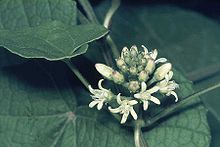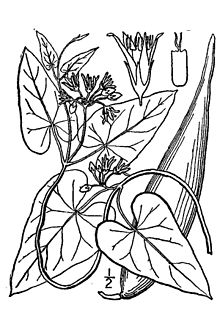- Cynanchum laeve
-
Cynanchum laeve 
Scientific classification Kingdom: Plantae (unranked): Angiosperms (unranked): Eudicots (unranked): Asterids Order: Gentianales Family: Apocynaceae Subfamily: Asclepiadoideae Genus: Cynanchum Species: C. laeve Binomial name Cynanchum laeve
(Michx.) Pers.Cynanchum laeve (syn. Ampelamus albidus) is a vining perennial herb native to eastern and central U.S. states and Ontario. Common names include honeyvine, honeyvine milkweed, bluevine milkweed, climbing milkweed, and smooth swallow-wort.
Like bindweed and some other members of the Convolvulaceae, Cynanchum laeve is a twining vine with heart-shaped leaves common in roadsides, fence rows, fields, and disturbed areas. However, C. laeve is easily recognized as a member of the Milkweed family by its opposite leave placement, milky sap and distinctive flowers and "milkweed pods." The seeds are wind dispersed and can travel long distances.[1]
Cynanchum laeve is considered a noxious weed in several states,[2] and can be very difficult to eradicate from fields because of its deep, extensive root system.[3] Like many other milkweed species, C. laeve contains toxic cardenolide alkaloids,[4] and is a food plant for the caterpillars of Monarch butterflies.[5]
References
- ^ Kansas Wildflowers and Grasses: Honeyvine Milkweed
- ^ USDA, NRCS. 2011. The PLANTS Database (http://plants.usda.gov/java/profile?symbol=CYLA, 19 June 2011). National Plant Data Team, Greensboro, NC 27401-4901 USA.
- ^ Kansas Wildflowers and Grasses: Honeyvine Milkweed
- ^ Burrows, G. E.; Tyrl, R. J., 2001. "Toxic plants of North America." Iowa State Univ Press, Ames. As referenced in the FDA Poisonous Plant Database
- ^ Kansas Native Plants: Butterfly Gardening
Categories:
Wikimedia Foundation. 2010.

